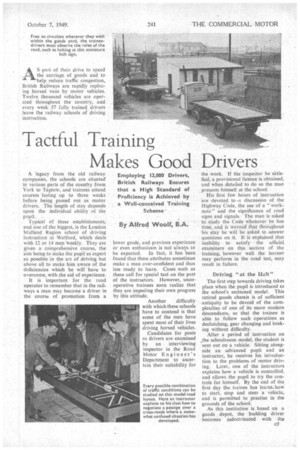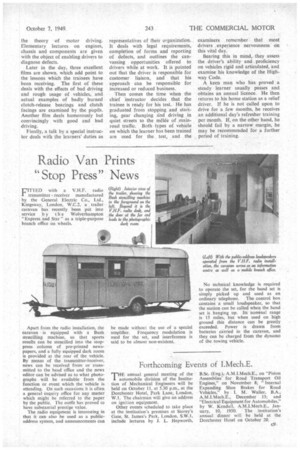Tactful Training Makes Good Drivers
Page 45

Page 46

Page 47

If you've noticed an error in this article please click here to report it so we can fix it.
Employing 12,000 Drivers, British Railways Ensures that a High Standard of Proficiency is Achieved by a Well-conceived Training Scheme '
By Alfred Woolf, BA. S part of their drive to speed the carriage of goods and to help reduce traffic congestion, British Railways are rapidly replacing horsed vans by motor vehicles. Twelve thousand vehicles are operated throughout the country, and every week 37 fully trained drivers leave the railway schools of driving instruction.
A legacy from the old railway companies, the schools are situated in various parts of the country from York to Taplow, and trainees attend courses lasting tip to three weeks before being passed out as motor drivers. The length of stay depends upon the individual ability of the pupil.
Typical Of these establishments; and one of the biggest, is the London Midland Region school of driving instruction" at Watford, which deals with 12 or 14 men—weekly. They are given a 'comprehensive course, the aim being to make the pupil as expert as possible in the art of driving but above all to make him aware of the deficiencies which he will have to -overcome, with the aid of experience.
It is important for the road operator to remember that in the railways a man may become a driver in the course of promotion from a lower grade, and previous experience or even enthusiasm is not always to
be expected. In fact, it has been found that these attributes sometimes make a man over-confident and thus less ready to learn. Cases such as these call for special tact on the part of the instructors. However, uncooperative trainees soon realize that they are impeding their own progress by this attitude.
Another difficulty with which these schools have to contend is that some of the men have spent most of their lives driving horsed vehicles.
Candidates for posts as drivers are examined by an interviewing inspector in the Road Motor Engineer's Department to ascertain their suitability for
the work. If the inspector be skisfled, a provisional licence is obtained, and when detailed to do so the man presents himself at the school.
His first few hours of instruction are devoted to -a discussion of the Highway Code, the use of a " worknote " and the significance of road signs and signals. The man is asked to study the Code whenever he has time and is warned that throughout his stay he will be asked to answer questions on it. It is explained that inability to satisfy the official examiners on this section of the training, however well the learner may perform in the road test, may result in failure.
Driving "at the Halt"
The first step towards driving takes place when the pupil is introduced to the school's sectioned model. This retired goods chassis is of sufficient antiquity to be devoid of the complexities of one of itsmore modern descendants, so that the trainee is able to follow such operations as declutching, gear changing and braking without difficulty.
After a period of instruction on „the schoolroom model, the student is sent out on a vehicle. Sitting alongside an advanced pupil and an instructor, he receives his introduction to the problems of motor driving. Later, one of the instructors explains how a vehicle is controlled, and allows the pupil to try the controls for himself. By the end of the first day the trainee has learnt, how to start, stop and steer a vehicle, and is permitted to practise in the grounds of the school.
As this institution is based on a goods depot, the budding driver becomes indoctrinated with the Cl
atmosphere in which he will have to work. He is also able to observe skilled drivers moving in and out of the loading bays, and instructors never fail to point aut good or bad driving technique; Vehicles used for instruction are mainly depreciated Seammeli 3-ton mechanical horses and trailers, and Dennis 2-ton rigid lorrim, so that trainees gain experience on the types which they are most likely to meet on return to their home stations. Furthermore, they drive all the instruction vehicles in turn, for a different technique is required in each case.
Three's Company
Other pupils at the school for two • or three days are the men who will eventually drive the long train of trolleys which are seen on main-line station platforms. They, too, receive training in all aspects of motor driving.
The next stage consists of watching an advanced pupil and an instructor on the road. The idea of a teacher dealing with two pupils, one more advanced than the other, has recently found favour in several fields of instruction.
If the beginner shows promise, he may be allowed a little later in the day to take the controls himself in some quiet district. The opportunity is then taken to indicate cornering technique. After a few hours of practical instruction, a further stage of classroom work is continued.
This time, emphasis is on practical traffic problems. 11:matter which is dealt with in some detail is position ing, this being considered important, as the vehicles are slow-moving and their presence in traffic,wrongly placed, can be most embarrassing to other road users.
For the purpose of these lessons, use is made of a model road layout in the school, whereby the pupils can study p'ractical road conditions in, as it were, slow motion. The model also serves to indicate the dangers attendant upon parking opposite other stationary vehicles, on the brow of a hill, or near a turning.
Slightly more advanced technique is graphically illustrated on the table, and methods of approaching crossroads when a right-hand turn is envisaged, and of negotiating roundabouts, once seen on the model, make a firm impression on the learner's mind.
On the third or fourth day the
trainee makes his first solo run round the yard, and from then onwards he is allowed to spend all available time driving about and gaining experience. Instructors are always on hand to help and certain artificial traffic hazards, simulating normal operation, are provided.
A further point is that each time' a learner takes out a vehicle, be it only for a 30-minute lesson, he must complete, as far as possible, his motor worknote. He thus starts his driving career in a way in which he will have to continue, fulfilling even the most elementary duties
Tricks of the Trade
When a fair degree of proficiency has been achieved, instruction on reversing •a mechanical horse and semi-trailer, and coupling and uncoupling units, follows. Reversing a Scammell and semi-trailer is not an easy matter, and tact is required by instructors. Their practice is to show the, pupil how to reverse and then leave him on his own.
He thus can tie himself up in knots until he remembers his instructor's advice and starts to do the job properly. This seems to be a wise course, because a man is more likely to make rniStakes in the presence of his instructor than when left to his own devices.
• Between periods of driving in the yard, -the trainee takes his turn on the road, and the instructor slowly brings him from quiet side streets into the busy thoroughfares. Trips on the road last about half-an-hour, after which the trainee returns to practise reversing, gear changing and uncoupling articulated units.
During the second week, when a fair degree of competence has been achieved, the trainees spend a day in the school, learning more about the theory of motor driving. Elementary lectures on engines, chassis and components are given with the object of enabling drivers to diagnose defects.
Later in the day, three excellent films are shown. which add point to the lessons which the trainees have been receiving. The first of these deals with the effects of bad driving and rough usage of vehicles, and actual examples of badly burned clutch-release bearings and clutch facings are examined by the pupils. Another film deals humorously but convincingly with good and bad driving.
Finally, a talk by a special instructor deals with the learners' duties as representatives of their organization. It deals with legal requirements, completion of forms and reporting of defects, and outlines the canvassing opportunities offered to drivers while at work. It is pointed out that the driver is responsible for customer liaison, and that his approach can be responsible for increased or reduced business.
Then comes the time when the chief instructor decides that the trainee is ready for his test. He has graduated from stopping and starting, gear changing gnd driving in quiet streets to the mêlée of mainroad traffic. Both types of vehicle on which the learner has been trained are used for the , test, and the examiners remember that most drivers . experience nervousness on this vital day.
Bearing this in mind, they assess the driver's ability and proficiency on vehicles rigid and articulated, and examine his knowledge of the Highway Code.
A keen man who has proved a steady learner usually passes and obtains an annual licence. He then returns to his home station as a relief driver. If he is not called upon to drive for a few months, he receives an additional day's refresher training per month. If, on the other hand, he should fail by a narrow margin, he may be recommended for a further period of training.




































































































